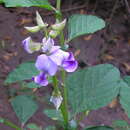Derivation of specific name
provided by Flora of Zimbabwe
semperflorens: ever-flowering, with a long flowering season
- license
- cc-by-nc
- copyright
- Mark Hyde, Bart Wursten and Petra Ballings
- bibliographic citation
- Hyde, M.A., Wursten, B.T. and Ballings, P. (2002-2014). Crotalaria semperflorens Vent. Flora of Zimbabwe website. Accessed 28 August 2014 at http://www.zimbabweflora.co.zw/cult/species.php?species_id=166230
- author
- Mark Hyde
- author
- Bart Wursten
- author
- Petra Ballings
Physical Description
provided by USDA PLANTS text
Annual, Herbs, Taproot present, Nodules present, Stems erect or ascending, Stems or branches arching, spreading or decumbent, Stems less than 1 m tall, Stems solid, Stems or young twigs sparsely to densely hairy, Leaves alternate, Leaves petiolate, Stipules conspicuous, Stipules green, triangulate to lanceolate or foliaceous, Stipules persistent, Stipules cordate, lobed, or sagittate, Leaves simple, or appearing so, Leaf or leaflet margins entire, Leaflets 1, Leaves glabrous or nearly so, Flowers in axillary clusters or few-floweredracemes, 2-6 flowers, Inflorescences racemes, Inflorescence terminal, Inflorescence leaf-opposed, Bracts very small, absent or caducous, Flowers zygomorphic, Calyx 5-lobed, Calyx hairy, Petals separate, Corolla papilionaceous, Petals white, Petals blue, lavander to purple, or violet, Petals bicolored or with red, purple or yellow streaks or spots, Banner petal suborbicular, broadly rounded, Wing petals narrow, oblanceolate to oblong, Keel abruptly curved, or spirally coiled, Stamens 9-10, Stamens or anthers dimorphic, alternating large and small, Stamens monadelphous, united below, Filaments glabrous, Style terete, Style hairy, Fruit a legume, Fruit stipitate, Fruit unilocular, Fruit freely dehiscent, Fruit elongate, straight, Fruit oblong or ellipsoidal, Fruit exserted from calyx, Fruit inflated or turgid, Fruit hairy, Fruit 11-many seeded, Seeds cordiform, mit-shaped, notched at one end, Seed surface smooth, Seeds olive, brown, or black.
Crotalaria verrucosa: Brief Summary
provided by wikipedia EN
Crotalaria verrucosa, the blue rattlepod, is a species of flowering plant in the legume family, Fabaceae. This shrub belongs to the subfamily Faboideae. The herb can be found in tropical and subtropical areas from in Bangladesh to Sri Lanka in South Asia, Southeast Asia, Australasia and Central America.
Crotalaria verrucosa is a perennial shrub that grows to about 50 to 100 cm in height.
- license
- cc-by-sa-3.0
- copyright
- Wikipedia authors and editors

